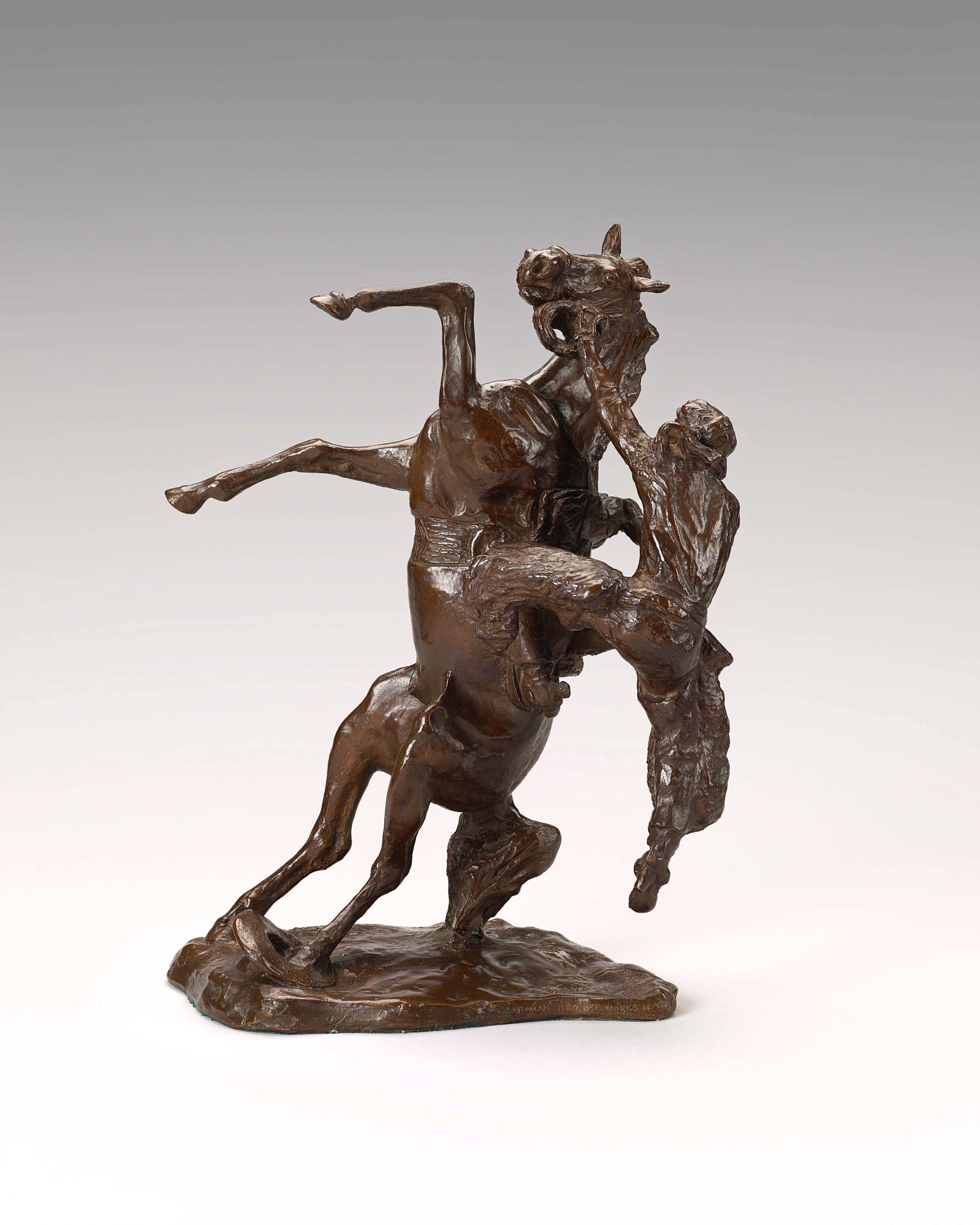
“Where the Best of Riders Quit” by Charles Marion Russell, modeled 1921-22, bronze. Petrie Collection, Denver, Colo. Photo by Bruce Fernandez, courtesy Denver Art Museum.
By Jessica Skwire Routhier
DENVER, COLO. — Just over a century ago, the “cowboy artist” Charles M. (Charlie) Russell (1864-1926) and his wife, Nancy Cooper Russell (1878-1940), were the toast of the town in Denver. From late November to early December 1921, they stayed at the Brown Palace Hotel on Broadway, which was hosting an exhibition of Charlie’s paintings and sculptures that Nancy had organized. Today, Denver’s residents and visitors have the opportunity to revisit that historic moment in “The Russells in Denver,” on view at the Denver Art Museum through June 30.
Just don’t call it a “recreation.” Via email, curator JR (Jennifer R.) Henneman corrected my use of that word. “We do not know what the original exhibition looked like,” she wrote. (While there are some photos of Charlie and Nancy during their time in Denver, the exhibition itself was not apparently photographed.) Instead, Henneman wrote me, “‘The Russells in Denver, 1921’ is a celebration of Charlie and Nancy’s two-week stay in the Mile High City that highlights many of the works we know were on display, tells the story of Denver in the 1920s, and acknowledges Nancy’s critical role in the Russell art enterprise.”
In this, the exhibition speaks to the mission of the Petrie Institute of Western American Art — the curatorial department at the Denver Art Museum (DAM) that Henneman directs — “to tell a comprehensive story of American art in the West.” The department is so named because of a major 2007 gift from Thomas A. and Jane Petrie, who lent seven of the 18 paintings and sculptures on the checklist for the present exhibition. Thomas Petrie, along with Henneman, has also contributed an essay to the catalog, and Petrie’s essay acknowledges the work of Russell scholar Brian Dippie in researching which of those works, in one form or another, were part of that original 1921 show.
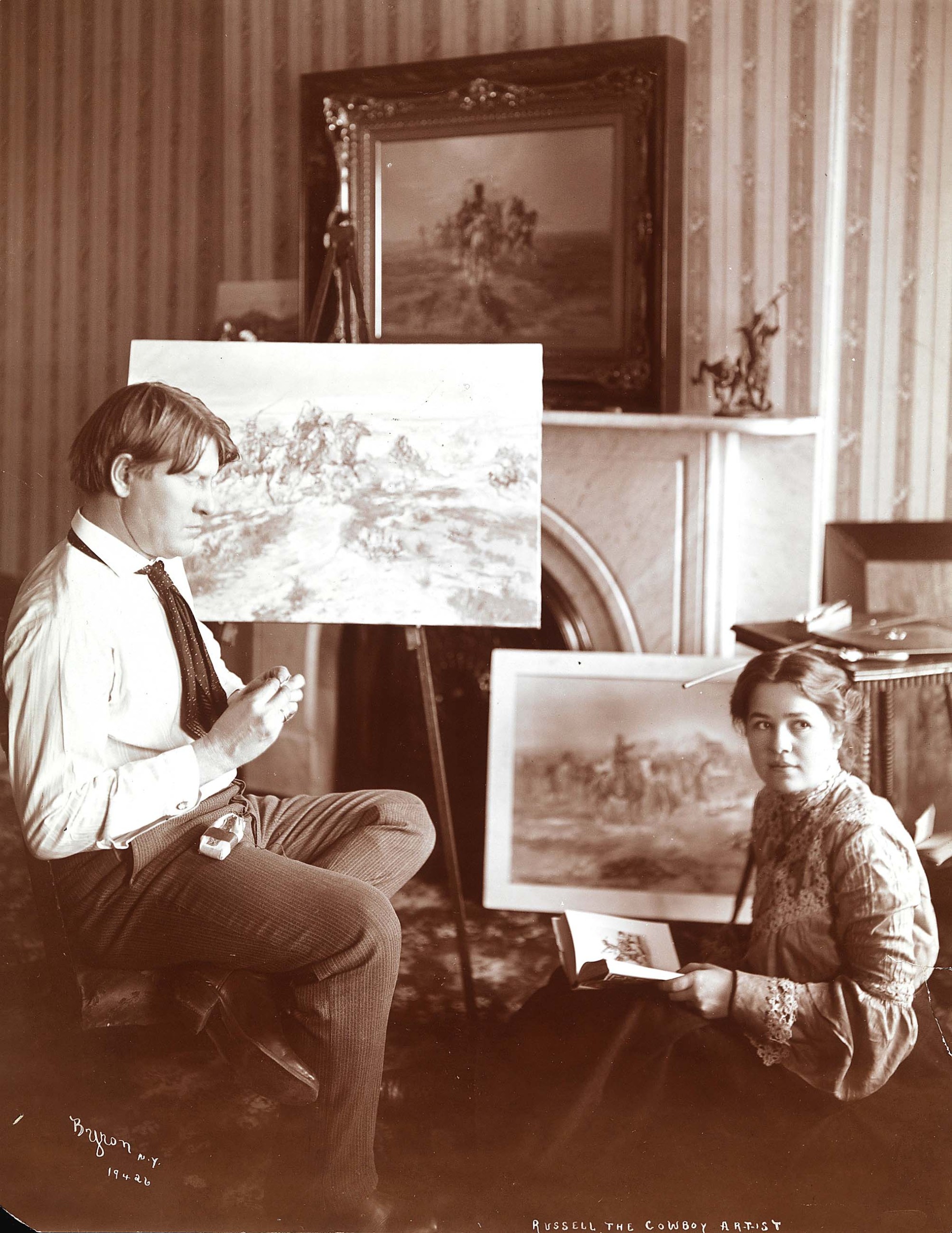
“Charlie and Nancy posing in front of some of their art in New York,” Byron Company photograph, February 1905. Museum of the City of New York Collection, New York City.
I use that qualification — “in one form or another” — because some of the sculptures literally take a different form in 2023-24 than they did in 1921. Charlie intended them to be bronzes from the first, but when the exhibition opened at the Brown Palace Hotel, they had not yet been cast and were instead included as plasters. Their chalky white surfaces would have created a very different aesthetic than the smooth, dark bronzes of works like “The Enemy’s Tracks” or “Weapons of the Weak” in the DAM’s exhibition. And, of course, the setting of the exhibition was different, too: a lavish turn-of-the-century hotel (still standing, with much of its décor still intact) versus the minimalist ambience of the Helen and Arthur E. Johnson Galleries of Western American Art in the DAM’s Martin Building, designed by Gio Ponti, which opened in 1971 and was renovated in 2021.
The two exhibitions have very different purposes, too. In 1921, Charlie Russell had been a working artist for 30 years, his efforts at the canvas buoyed by Nancy Russell’s sharp business sense and flair for marketing and publicity. Nancy was “firmly in the saddle” in that role by then, writes Petrie in his catalog essay, and the Brown Hotel show was strategically engineered to open up a new market for Charlie’s work. Everything on view was for sale except for the plasters — although Nancy could take orders for the finished bronze versions.
The goals of the DAM exhibition, by contrast, align with the educational mission of both the Petrie Institute and the museum itself. The works are there not to be acquired but to be experienced and, ideally, to provide an entrée into learning more about the artist, Denver’s history and the American West. There is also a more mundane goal here, however. With Petrie (who is also a DAM trustee), as essayist, lender and named funder of the curatorial department organizing the show — and with more than 70 percent of the works on the checklist lent from private collections (not just the Petries’) — “The Russells in Denver” is clearly a donor cultivation tool.
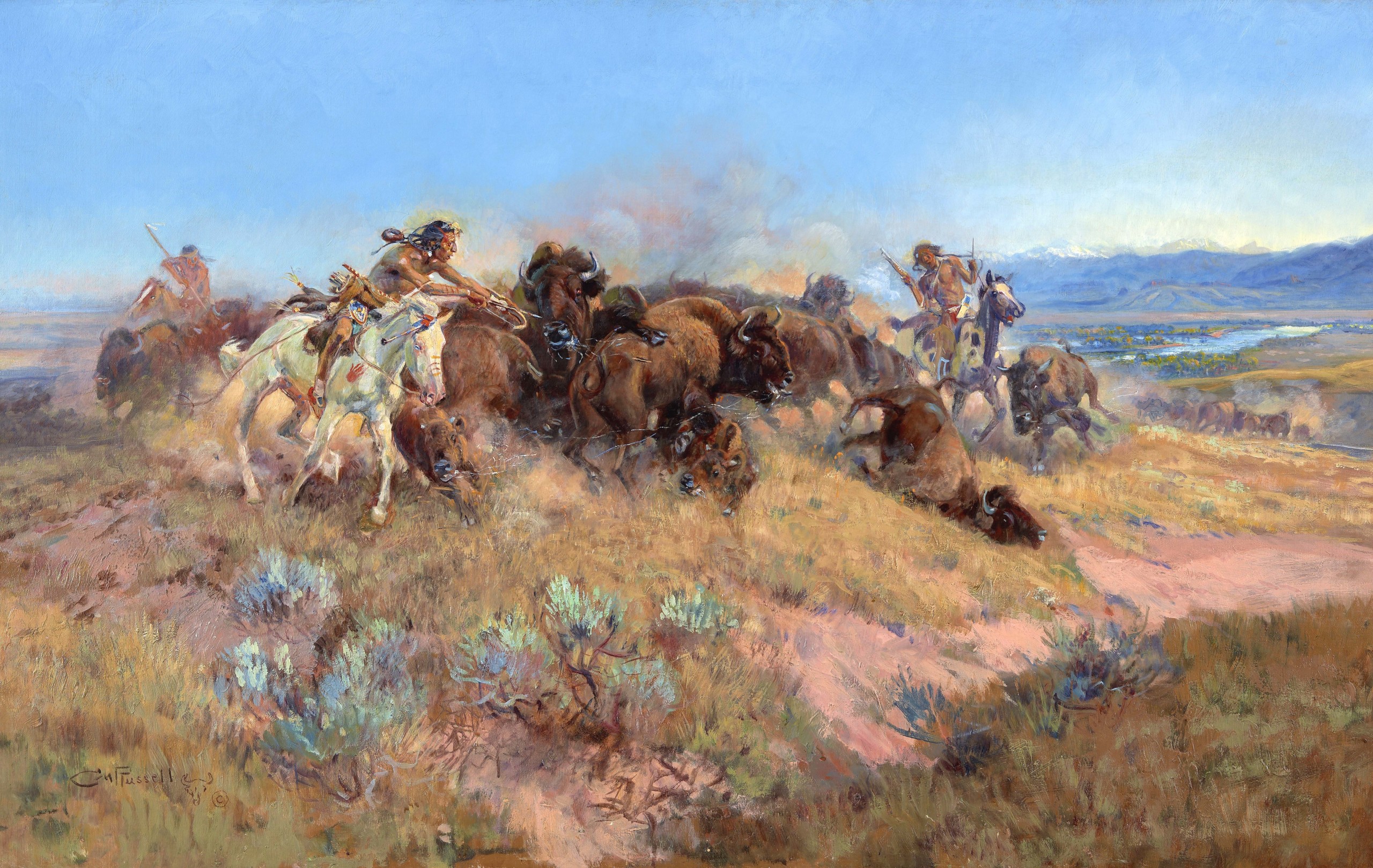
“Buffalo Hunt, Number 40” by Charles Marion Russell, 1919, oil on canvas, 39 by 57 inches. Petrie Collection, Denver, Colo. Photo by Christina Jackson, courtesy of the Denver Art Museum.
This does not mean it is without merit, of course. Charlie Russell’s gifts are undeniable: both his animated and ambitious bronzes, notably “Where the Best Riders Quit” from the Petrie collection, and his action-packed, highly chromatic paintings — “When Mules Wear Diamonds,” on loan from the National Cowboy and Western Heritage Museum, is a standout — rival those of any others working in this genre. Nor should wooing donors be anything to apologize for. For better or worse, American museums run on private funding, and in this regard using exhibitions to attract, retain or acknowledge key donors is arguably in service of the museum’s mission and, ultimately, to the benefit of its visitors.
In fact, the display is somewhat timely, with an interest in the late Nineteenth and early Twentieth Century paintings of the American West experiencing something of a Renaissance among scholars and museums. In just a few months, the Nevada Museum of Art will open “Sagebrush and Solitude: Maynard Dixon in Nevada,” featuring a contemporary of Charlie Russell’s, and the DAM itself was an organizing institution for “Mythmakers: The Art of Winslow Homer and Frederic Remington,” which toured in 2020-21. It is interesting to compare this show to that one, which I also covered for this publication. “Mythmakers” dealt candidly with Remington’s exoticized depictions of Indigenous Americans and, more broadly, with problems inherent in the different mythic Americas pictured in both Remington’s and Homer’s works. The curators, including Henneman, solicited guest-written object labels, many from Indigenous or multicultural perspectives, going a long way to open up the interpretation beyond standard, often anodyne museum texts crafted to do little beyond excite admiration for the artwork.
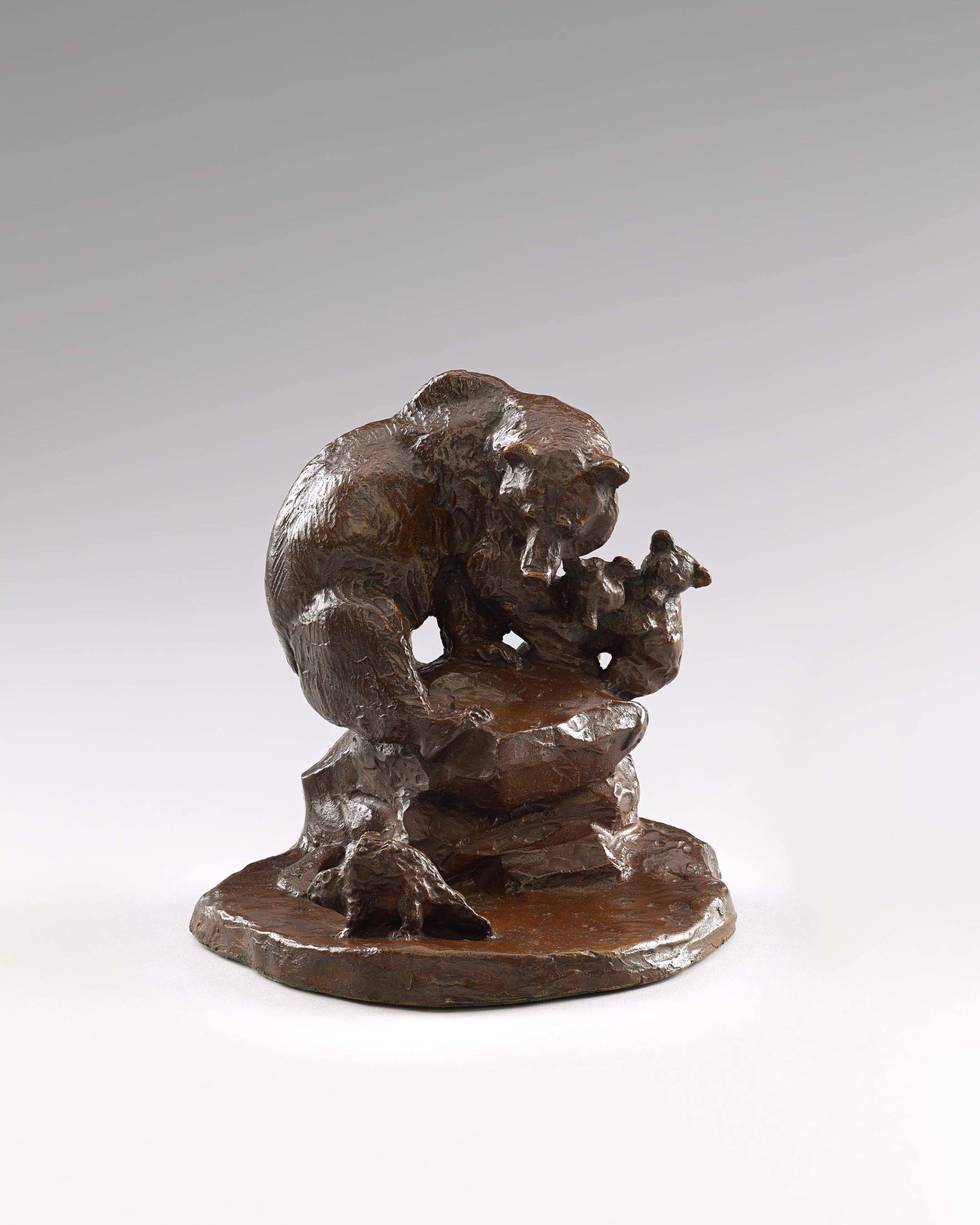
“Weapons of the Weak” by Charles Marion Russell, modeled 1921, bronze; 5¾ by 5-7/8 by 5½ inches. Petrie Collection, Denver, Colo. Photo by Bruce Fernandez, courtesy Denver Art Museum.
Such strategies might also have benefited the present exhibition. I asked Henneman specifically, via email, about how “The Russells in Denver” deals with such mythologized or partial images of the American West, particularly Charlie’s depictions of Indigenous Americans, and she referred me to the exhibition texts, which she says acknowledge Charlie’s “many sources, including other artists, histories shared by Blackfeet elders, and his own observations and imagination.” The texts provided to me, however, revealed little more on that subject than Henneman’s brief response, which paraphrased the label for “Buffalo Hunt No. 40.”
She also referred me to the larger mission of the Petrie Institute, which she described as “surfacing overlooked or undervalued perspectives and forthrightly addressing questions of representation through thoughtful analysis of artworks and art histories” — but, again, the present exhibition seems to have foregrounded other objectives. The labels tell us a lot about Charlie’s strengths as a colorist; we learn what a “latigo” strap and a “diamond hitch” are; and we read frequent encomiums to Nancy, if not a lot of detail. (Henneman told me that “significant scholarship on Nancy’s life and role as business and marketing manager remains to be done.”) One quantifiable contribution to a more open approach to interpretation is that the exhibition texts are, laudably, presented in both English and Spanish.
The modest catalog that accompanies the exhibition provides somewhat more detail on Charlie’s and Nancy’s stories and on the background of certain paintings and sculptures. Here, in the text for the painting “In the Enemy’s Country,” showing Kootenai men on horseback moving through Blackfeet country, we learn that “Charlie knew Native Americans from both tribes and…was sensitive to and enthralled by their histories.” The catalog text for “Wagons,” showing a group of mounted Plainsmen observing a wagon train in the distance, states that Charlie’s “sympathies were not with the white invaders” and that his “illustrations stand in contrast to many stereotypically negative portrayals…of Native Americans.” Fair enough. But these things can be demonstrably true and still be only partial truths. The most exciting and important research happening today on the artists of the American West finds nuance and texture between “creators of racist caricatures” and “good guys whose work was celebratory.” Given the stated mission of the Petrie Institute and its prominence in the field, it owes its visitors that kind of thoughtful analysis.
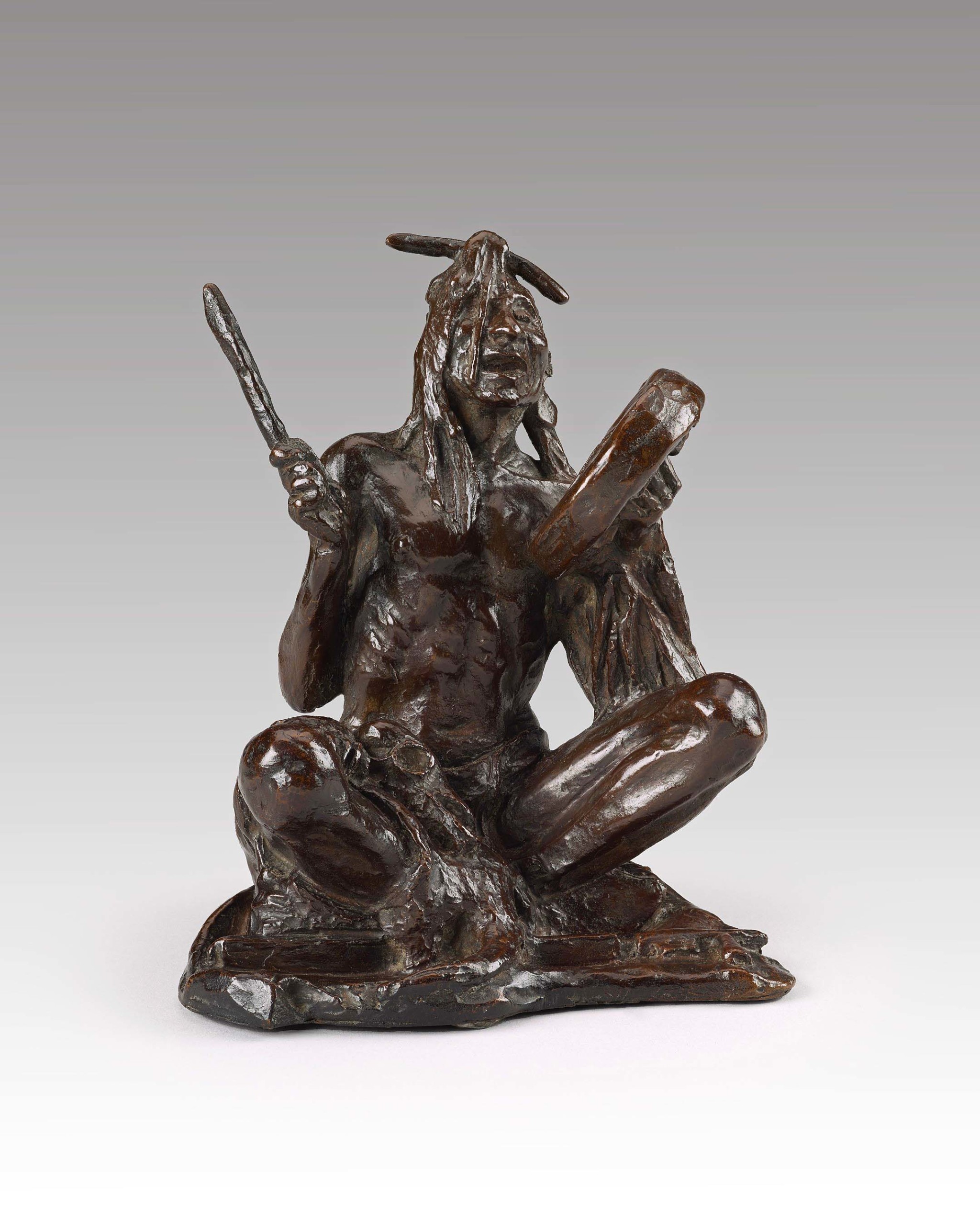
“The Medicine Man” by Charles Marion Russell, modeled 1920, bronze, 7½ by 5-7/8 by 5½ inches. Petrie Collection, Denver, Colo. Photo by Bruce Fernandez, courtesy Denver Art Museum.
For instance, interpretation is minimal for two striking bronzes, “Medicine Man” and “Snake Priest.” The gallery texts I received did not address either of them, and Petrie’s treatment in the cataloguis brief: “‘The Medicine Man’ is a sensitively crafted depiction of the Native American to whom tribe members appealed for healing and wisdom…In ‘The Snake Priest,’ the artist takes up the Southwest Hopi Snake Ceremony.” The thoughtful visitor (or reader) is left with a surfeit of questions: Does “The Medicine Man” represent a figure from a specific Indigenous community? Would Charlie Russell, as a white man, have had access to such rituals? How accurately does “The Snake Priest” represent the Hopi ceremony? Do those Indigenous communities still practice such ceremonies? How might members of those communities have perceived these sculptures then, and how do they perceive them now? Certainly, museum visitors (and commentators) should be free to draw their own conclusions about the art they see, but a fuller historical and social context will better equip them to do so.
I offer one more example, related to the aforementioned “Buffalo Hunt No. 40.” Petrie writes that the painting represents a traditional Indigenous hunting technique no longer in use in 1919 but that Charlie may have learned about from his Blackfeet connections. He also mentions that Charlie had “participated in the Pablo Buffalo drives of 1907, 1908 and 1909, the last of the major buffalo roundups” — but leaves it at that. Perhaps a local Denver audience will already know the story behind the Pablo drives, but I had to look it up. I learned that Michel Pablo and Charles Allard, both mixed-race Indigenous men, were instrumental in the preservation of the American bison, which the US government had brought to the brink of extinction with the goal of disempowering the Plains tribes that depended on them. The Pablo-Allard herd grew to some 700 head before it was sold to Canada and driven from the US plains north of the border. That Charlie participated in this event — in whatever unspecified context — puts action behind the assertion that he was a friend to Indigenous communities, and just a little more detail would have completed that connection for visitors and readers while offering a teaching moment about a key event in US history.
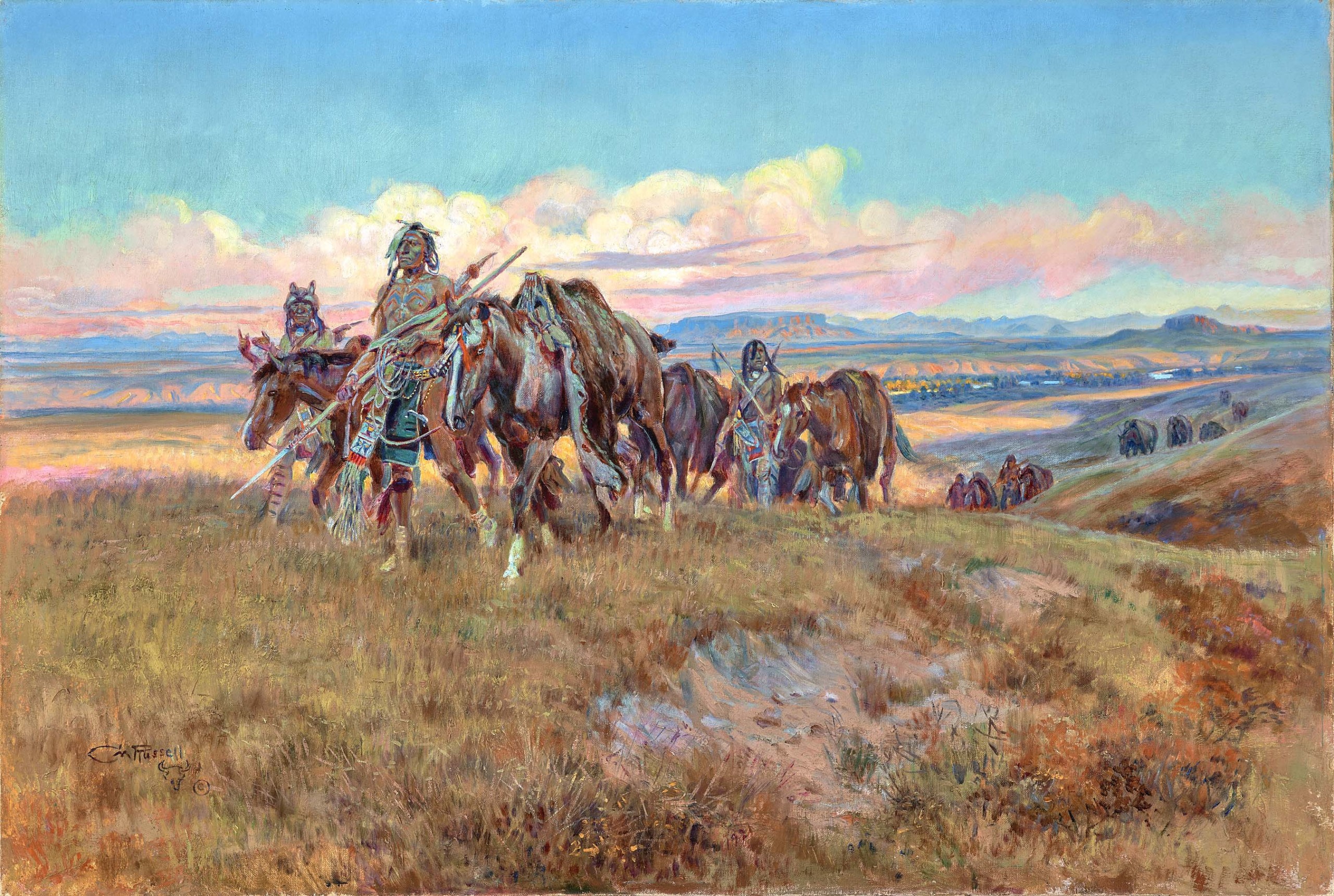
“In the Enemy’s Country” by Charles Marion Russell, 1921, oil on canvas, 24 by 36 inches. Denver Art Museum: Gift of the Magness Family in memory of Betsy Magness. Photo by Christina Jackson, Denver Art Museum.
I do not mean to argue that this exhibition should be something it is not. In fact, I appreciate and acknowledge the worthiness in both the art-historical experiment this exhibition attempts as well as its goal of highlighting Nancy Russell’s crucial role in her husband’s success. But the actual content of the art is not ancillary to the Russells’ story, and it is, after all, what is on view. A more thoroughly researched approach, with a more fleshed-out interpretive plan — acknowledging the complexities of viewing these works in their moment of creation/initial display and now — might have better served the DAM’s stated and unstated goals for this exhibition. The good news is that both the Petrie Institute and Henneman have already demonstrated their willingness and ability to do just that, and so perhaps the next time some of the Brown Hotel Russells are on view — the DAM owns three of them outright — we will learn as much about who they represent as about who created them.
The Denver Art Museum is at 100 West 14th Avenue Parkway. For additional information, www.denverartmuseum.org or 720-865-5000.


















